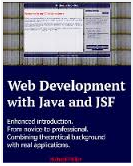[OmniFaces utilities] The
getAnnotation() get program element annotation of a certain annotation type. The difference with Annotated#getAnnotation(Class) is that this method will recursively search inside all Stereotype annotations.Method:
This is a
dummy example, but you should get the idea from it. First, we have defined a
dummy CDI stereotype:
// DummyStereotype
package
some.beans;
import
static java.lang.annotation.ElementType.FIELD;
import
java.lang.annotation.Retention;
import
static java.lang.annotation.RetentionPolicy.RUNTIME;
import
java.lang.annotation.Target;
import
javax.enterprise.inject.Stereotype;
@Stereotype
@Target(FIELD)
@Retention(RUNTIME)
public
@interface DummyStereotype {
}
A dummy BeanA:
// BeanA
package
some.beans;
import
javax.enterprise.context.RequestScoped;
import
javax.inject.Named;
@Named
@RequestScoped
public class
BeanA {
}
An injection
point of BeanA
in BeanB
with dummy stereotype:
// BeanB
package
some.beans;
import
javax.enterprise.context.RequestScoped;
import
javax.inject.Inject;
import
javax.inject.Named;
@Named
@RequestScoped
public class
BeanB {
@Inject @DummyStereotype
BeanA a;
}
A dummy BeanC with
a simple method dedicated to test the default Annotated#getAnnotation()
and the OmniFaces, Beans#getAnnotation():
// BeanC
package
some.beans;
import
java.lang.annotation.Retention;
import
java.lang.annotation.Target;
import
java.util.Set;
import
javax.enterprise.context.RequestScoped;
import
javax.enterprise.inject.spi.Annotated;
import
javax.enterprise.inject.spi.Bean;
import
javax.enterprise.inject.spi.InjectionPoint;
import
javax.inject.Named;
import
org.omnifaces.util.Beans;
@Named
@RequestScoped
public class
BeanC {
public void inspectAnnotations() {
Bean<BeanB> beanBresolved =
Beans.resolve(BeanB.class);
Set<InjectionPoint> injectionPoints =
beanBresolved.getInjectionPoints();
if
(injectionPoints.size() > 0) {
beanBresolved.getInjectionPoints().stream().forEach((candidate)
-> {
Annotated annotated =
candidate.getAnnotated();
System.out.println("All annotations:
" + annotated.getAnnotations());
// default Annotated#getAnnotation()
//Retention retention = annotated.getAnnotation(Retention.class);
//Target
target = annotated.getAnnotation(Target.class);
//OmniFaces Beans#getAnnotation()
Retention retention =
Beans.getAnnotation(annotated, Retention.class);
Target target =
Beans.getAnnotation(annotated, Target.class);
if (retention != null) {
System.out.println("retention=" +
retention.value().name());
} else {
System.out.println("NULL");
}
if (target != null) {
System.out.println("target=" +
target.value()[0]);
}
else {
System.out.println("NULL");
}
});
} else {
System.out.println("No injection point
found !!!");
}
}
}
Output for
default
Annotated#getAnnotation():
All
annotations: [@javax.inject.Inject(), @some.beans.DummyStereotype()]
NULL
NULL
Output for
default
Beans#getAnnotation():
All
annotations: [@javax.inject.Inject(), @some.beans.DummyStereotype()]
retention=RUNTIME
target=FIELD
API GH











 JSF 2 Tutorials at www.mkyong.com
JSF 2 Tutorials at www.mkyong.com  JavaServer Faces (JSF) Tutorial
JavaServer Faces (JSF) Tutorial 




















Niciun comentariu :
Trimiteți un comentariu